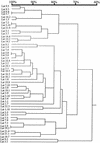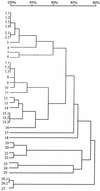Diversity at the locus associated with transcription of a variable surface antigen of Pneumocystis carinii as an index of population structure and dynamics in infected rats
- PMID: 12496148
- PMCID: PMC143281
- DOI: 10.1128/IAI.71.1.47-60.2003
Diversity at the locus associated with transcription of a variable surface antigen of Pneumocystis carinii as an index of population structure and dynamics in infected rats
Abstract
Pneumocystis carinii expresses a surface glycoprotein called MSG. Different isoforms of MSG are encoded by a gene family spread over at least 15 telomeric sites. Only one locus, called UCS, supports the production of MSG mRNA. Previous studies showed that P. carinii populations from individual rats exhibited high degrees of diversity with respect to the MSG genes attached to the UCS locus. This diversity could have been generated primarily in the rats studied. Alternatively, the rats may have been infected by P. carinii organisms that were already different at the UCS locus. To investigate this issue, we examined the UCS locus in P. carinii from rats that had been exposed to few of the microbes at a specified time, which produced a bottleneck in the microbial population. Some of the rats with bottlenecks produced P. carinii populations in which a single MSG sequence resided at the UCS locus in 80 to 90% of the organisms, showing that P. carinii can proliferate within a rat without generating the very high levels of UCS diversity previously seen. From the degree of diversity observed in the bottlenecked populations, the maximum rate of switching appeared to be 0.01 event per generation. These data also suggest that the infectious dose is as low as one organism, that rats that share a cage readily infect each other, and that the doubling time of P. carinii in vivo is approximately 3 days. In addition, we found that inoculation with 10(7) P. carinii organisms from a population highly heterogeneous at the UCS locus reproduced this heterogeneity. By contrast, shifts in population structure occurred in rats given 10(4) P. carinii organisms, suggesting that a small fraction of these proliferated.
Figures







Similar articles
-
Residence at the expression site is necessary and sufficient for the transcription of surface antigen genes of Pneumocystis carinii.Mol Microbiol. 1997 Jul;25(1):147-60. doi: 10.1046/j.1365-2958.1997.4461806.x. Mol Microbiol. 1997. PMID: 11902717
-
Translocation of surface antigen genes to a unique telomeric expression site in Pneumocystis carinii.Mol Microbiol. 1996 Jan;19(2):283-95. doi: 10.1046/j.1365-2958.1996.375905.x. Mol Microbiol. 1996. PMID: 8825774
-
The major surface glycoprotein expression sites of two special forms of rat Pneumocystis carinii differ in structure.J Infect Dis. 2000 May;181(5):1729-39. doi: 10.1086/315438. Epub 2000 May 15. J Infect Dis. 2000. PMID: 10823775
-
Antigenic variation in pneumocystis.J Eukaryot Microbiol. 2007 Jan-Feb;54(1):8-13. doi: 10.1111/j.1550-7408.2006.00225.x. J Eukaryot Microbiol. 2007. PMID: 17300510 Review.
-
Genetics of surface antigen expression in Pneumocystis carinii.Infect Immun. 2001 Feb;69(2):627-39. doi: 10.1128/IAI.69.2.627-639.2001. Infect Immun. 2001. PMID: 11159949 Free PMC article. Review.
Cited by
-
Is the unique camouflage strategy of Pneumocystis associated with its particular niche within host lungs?PLoS Pathog. 2019 Jan 24;15(1):e1007480. doi: 10.1371/journal.ppat.1007480. eCollection 2019 Jan. PLoS Pathog. 2019. PMID: 30677096 Free PMC article. Review. No abstract available.
-
The frequency and rate of pilin antigenic variation in Neisseria gonorrhoeae.Mol Microbiol. 2005 Oct;58(2):510-9. doi: 10.1111/j.1365-2958.2005.04838.x. Mol Microbiol. 2005. PMID: 16194236 Free PMC article.
-
Pneumocystis murina MSG gene family and the structure of the locus associated with its transcription.Fungal Genet Biol. 2007 Sep;44(9):905-19. doi: 10.1016/j.fgb.2007.01.004. Epub 2007 Jan 10. Fungal Genet Biol. 2007. PMID: 17320432 Free PMC article.
-
Increased fidelity reduces poliovirus fitness and virulence under selective pressure in mice.PLoS Pathog. 2005 Oct;1(2):e11. doi: 10.1371/journal.ppat.0010011. Epub 2005 Oct 7. PLoS Pathog. 2005. PMID: 16220146 Free PMC article.
-
Transcriptome of Pneumocystis carinii during fulminate infection: carbohydrate metabolism and the concept of a compatible parasite.PLoS One. 2007 May 9;2(5):e423. doi: 10.1371/journal.pone.0000423. PLoS One. 2007. PMID: 17487271 Free PMC article.
References
-
- Aliouat, E. M., R. Escamilla, C. Cariven, C. Vieu, C. Mullet, E. Dei-Cas, and M. C. Prevost. 1998. Surfactant changes during experimental pneumocystosis are related to Pneumocystis development. Eur. Respir. J. 11:542-547. - PubMed
-
- Anonymous. 1994. Revised nomenclature for Pneumocystis carinii. The Pneumocystis Workshop. J. Eukaryot. Microbiol. 41:121S-122S. - PubMed
-
- Armstrong, M. Y., and M. T. Cushion. 1994. Animal models, p. 181-222. In P. D. Walzer (ed.), Pneumocystis carinii pneumonia. Marcel Dekker, New York, N.Y.
Publication types
MeSH terms
Substances
Grants and funding
LinkOut - more resources
Full Text Sources

